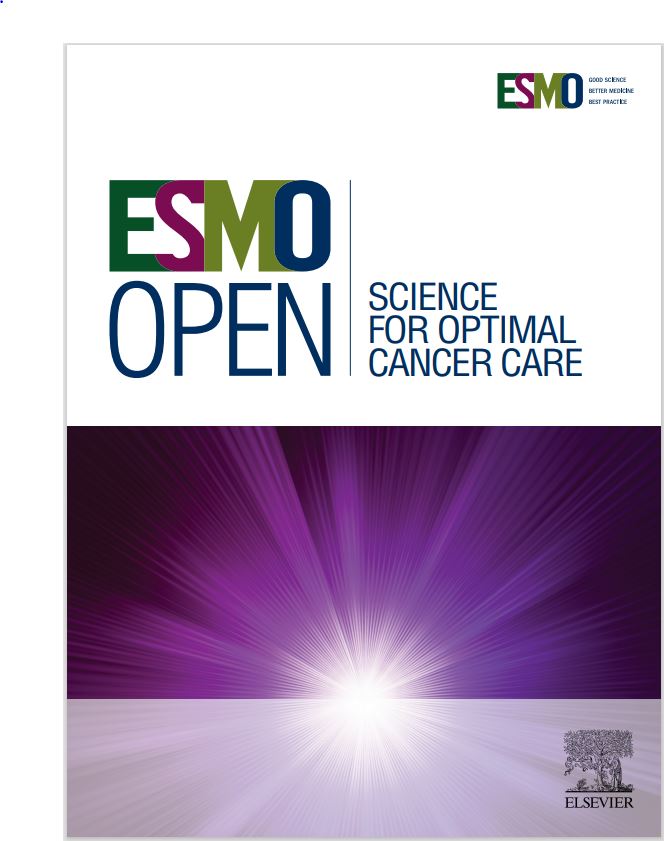第一周期6-8小时门诊监测与48小时住院监测塔拉他单的安全性:delphi -300期1期亚研究
IF 7.1
2区 医学
Q1 ONCOLOGY
引用次数: 0
摘要
tarlatamab是一种靶向δ样配体3的双特异性t细胞参与免疫疗法,已经证明在小细胞肺癌(SCLC)中有很好的生存效果。考虑到细胞因子释放综合征(CRS)的风险,最初的临床试验在第1周期进行了48-72小时的住院监测。方法先前接受过SCLC治疗的患者被纳入了delphi -300 F部分,该研究评估了每2周(Q2W) 10 mg的塔拉他单抗的安全性,并在第1周期给药后进行6-8小时门诊监测。研究的主要终点是安全性,与服用tarlatamab 10mg Q2W、48小时住院监测第1周期剂量的患者进行比较。结果在第1周期,门诊组(n = 30)和住院组(n = 58)的治疗相关不良事件和住院率(分别为93%对100%和27%对34%)相似,包括急诊室就诊。在第1周期,门诊组和住院组的所有级别和严重CRS发生率相似(任何级别:60%对62%;严重:17%对22%)。两组患者到CRS缓解的中位时间均为3天。安全性结果,包括住院率,在第1周期给予塔拉他单抗10mg Q2W, 6-8小时门诊监测与48小时住院监测的首次人体研究中相似。本文章由计算机程序翻译,如有差异,请以英文原文为准。
Safety of tarlatamab with 6-8-h outpatient versus 48-h inpatient monitoring during cycle 1: DeLLphi-300 phase 1 substudy
Background
Tarlatamab, a bispecific T-cell engager immunotherapy targeting delta-like ligand 3, has demonstrated promising survival outcomes in small-cell lung cancer (SCLC). Given the risk of cytokine release syndrome (CRS), initial clinical trials incorporated 48-72-h inpatient monitoring in cycle 1.
Methods
Patients with previously treated SCLC were enrolled into DeLLphi-300 part F, which evaluated the safety of tarlatamab 10 mg every 2 weeks (Q2W) with 6-8-h outpatient monitoring following cycle 1 doses. The primary endpoint, safety, was compared with patients from DeLLphi-300 part A receiving tarlatamab 10 mg Q2W with 48-h inpatient monitoring for cycle 1 doses.
Results
In cycle 1, the rates of treatment-related adverse events and hospitalizations, including emergency room visits, were similar between outpatient (n = 30) and inpatient (n = 58) groups (93% versus 100% and 27% versus 34%, respectively). The incidence of all grade and serious CRS during cycle 1 was similar between outpatient and inpatient groups (any grade: 60% versus 62%; serious: 17% versus 22%). The median time to CRS resolution was 3 days for both groups.
Conclusions
Safety outcomes, including hospitalization rates, were similar in this first-in-human study following tarlatamab 10 mg Q2W administration with 6-8-h outpatient versus 48-h inpatient monitoring in cycle 1.
求助全文
通过发布文献求助,成功后即可免费获取论文全文。
去求助
来源期刊

ESMO Open
Medicine-Oncology
CiteScore
11.70
自引率
2.70%
发文量
255
审稿时长
10 weeks
期刊介绍:
ESMO Open is the online-only, open access journal of the European Society for Medical Oncology (ESMO). It is a peer-reviewed publication dedicated to sharing high-quality medical research and educational materials from various fields of oncology. The journal specifically focuses on showcasing innovative clinical and translational cancer research.
ESMO Open aims to publish a wide range of research articles covering all aspects of oncology, including experimental studies, translational research, diagnostic advancements, and therapeutic approaches. The content of the journal includes original research articles, insightful reviews, thought-provoking editorials, and correspondence. Moreover, the journal warmly welcomes the submission of phase I trials and meta-analyses. It also showcases reviews from significant ESMO conferences and meetings, as well as publishes important position statements on behalf of ESMO.
Overall, ESMO Open offers a platform for scientists, clinicians, and researchers in the field of oncology to share their valuable insights and contribute to advancing the understanding and treatment of cancer. The journal serves as a source of up-to-date information and fosters collaboration within the oncology community.
 求助内容:
求助内容: 应助结果提醒方式:
应助结果提醒方式:


